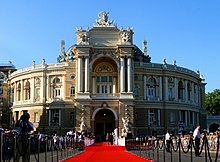 The Italian baroque facade of the Odesa Opera and Ballet Theater. It was started with the important contribution of the Italians of Odesa | |
| Total population | |
| Extinct | |
| Regions with significant populations | |
| Odesa | |
| Languages | |
| Religion | |
| Catholic | |
| Related ethnic groups | |
| Italians, Italians of Crimea |
The Italians of Odesa (Italian: italiani di Odessa; Ukrainian: Італійці з Одеси, romanized: Italiytsi z Odesy; Russian: Итальянцы из Одессы, romanized: Ital'yantsy iz Odessy) were an ethnic minority that once resided in Odesa, a city in southern Ukraine on the Black Sea. Italians of Odesa, whose ancestors were Italians who emigrated to Odesa during the Italian diaspora, are mentioned for the first time in documents of the 13th century.[1] The influx of Italians in southern Ukraine grew particularly with the foundation of Odesa, which took place in 1794.[1] In 1797 there were about 800 Italians in Odesa, equal to 10% of the total population.[2] For more than a century the Italians of Odesa greatly influenced the culture, art, industry, society, architecture, politics and economy of the city.[3][4][5][6][1] Among the works created by the Italians of Odesa there were the Potemkin Stairs and the Odesa Opera and Ballet Theater.[1] At the beginning of the 19th century the Italian language became the second official language in Odesa, after Russian.[1]
Until the 1870s, Odesa's Italian population grew steadily.[3] From the following decade this growth stopped, and the decline of the Italian community in Odesa began.[3] The reason was mainly one, namely the gradual integration into the Slavic population of Odesa, i.e. Russians and Ukrainians.[3] Surnames began to be Russianized and Ukrainianized.[3] The revolution of 1917 sent many of them to Italy, or to other cities in Europe.[5] In Soviet times, only a few dozen Italians remained in Odesa, most of whom no longer knew their own language.[7] Over time they merged with the local population, losing the ethnic connotations of origin.[8] They disappeared completely by World War II.[8]
- ^ a b c d e Cite error: The named reference
reportdifesawas invoked but never defined (see the help page). - ^ Cite error: The named reference
Dundovichwas invoked but never defined (see the help page). - ^ a b c d e Cite error: The named reference
lavitawas invoked but never defined (see the help page). - ^ Cite error: The named reference
brandeswas invoked but never defined (see the help page). - ^ a b Cite error: The named reference
italianiwas invoked but never defined (see the help page). - ^ Cite error: The named reference
eastjournalwas invoked but never defined (see the help page). - ^ Cite error: The named reference
cnrwas invoked but never defined (see the help page). - ^ a b Cite error: The named reference
Leoniwas invoked but never defined (see the help page).